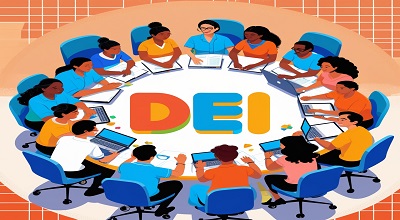DEI in Educator Development
DEI in Educator Development: Diversity, Equity, and Inclusion (DEI) have become essential pillars in modern education, shaping how educators are trained, developed, and supported. As classrooms grow more diverse, teacher preparation programs must evolve to ensure educators are equipped with the skills to foster inclusive learning environments.
This comprehensive guide explores the latest trends, strategies, and real-world examples of DEI in educator development. Whether you’re a teacher, administrator, or policymaker, understanding these principles will help create more equitable educational experiences for all students.
Understanding DEI in Educator Development
Definition and Importance
DEI stands for Diversity, Equity, and Inclusion, three interconnected principles that ensure fair treatment, access, and opportunities for all individuals, regardless of their background.
- Diversity: Recognizing differences in race, gender, ethnicity, religion, disability, and socioeconomic status.
- Equity: Providing resources and support based on individual needs to achieve fairness.
- Inclusion: Creating environments where all individuals feel valued and respected.
In educator development, DEI ensures that teachers are prepared to address systemic inequities and meet the needs of diverse student populations.
Why DEI Matters in Teacher Training?
- Improves Student Outcomes: Teachers trained in DEI strategies are better equipped to engage students from various backgrounds.
- Reduces Bias: Awareness of implicit biases helps educators make fairer decisions in grading, discipline, and student support.
- Prepares for Global Classrooms: As student demographics shift, DEI training ensures educators can adapt to multicultural settings.
Key Components of DEI in Educator Preparation
Culturally Responsive Teaching
This approach encourages educators to incorporate students’ cultural references into learning.
Example: A history teacher includes lessons on indigenous perspectives alongside traditional curricula.
Implicit Bias Training
Helps educators recognize unconscious prejudices that may affect their teaching.
Example: Workshops using Harvard’s Implicit Association Test (IAT) to uncover hidden biases.
Inclusive Curriculum Design
Ensures learning materials represent diverse voices and experiences.
Example: Literature courses including works by authors of color, LGBTQ+ voices, and disabled writers.
Latest Trends in DEI for Teacher Development
Micro-Credentials in DEI
Many institutions now offer short, competency-based certifications in DEI topics.
Example: The University of Southern California’s DEI micro-credential program for educators.
AI and Personalized DEI Training
AI-driven platforms provide customized DEI training based on educators’ needs.
Example: KickUp uses AI to recommend DEI resources for teachers.
Global Perspectives on DEI in Education
Countries like Canada and Finland integrate DEI into national teacher standards.
Real-World Examples of DEI in Educator Development
1: Harvard’s Project Implicit for Teachers
- Helps educators identify unconscious biases.
- Used in over 500 school districts globally.
2: Teach For America’s DEI Initiatives
- Requires DEI training for all corps members.
- Focuses on anti-racist teaching practices.
3: Singapore’s Multicultural Teacher Training
- Mandates DEI modules in teacher certification programs.
- Emphasizes multilingual and intercultural competence.
Challenges and Solutions in Implementing DEI
Resistance to DEI Programs
- Challenge: Some educators view DEI as political rather than pedagogical.
- Solution: Framing DEI as a tool for improving student engagement and success.
Measuring the Impact of DEI Training
- Challenge: Lack of standardized metrics.
- Solution: Using student feedback, classroom observations, and academic performance data.
Future of DEI in Educator Development
- Policy Changes: More states are mandating DEI training for teacher licensure.
- Technology: VR simulations for empathy-building in DEI training.
FAQs
Q1: How can schools start implementing DEI training?
A: Begin with workshops, integrate DEI into hiring practices, and revise curricula.
Q2: What are some free DEI resources for teachers?
A: Teaching Tolerance, Edutopia’s DEI guides, and Harvard’s Project Implicit.
Conclusion
DEI in educator development is not just a trend—it’s a necessity for fostering inclusive, equitable classrooms. By adopting these strategies, schools can better prepare teachers to serve all students effectively.
